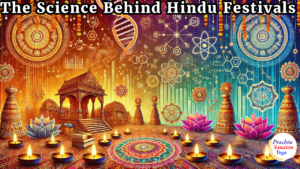
The Science Behind Hindu Festivals
The Science Behind Hindu Festivals
The Hindu festivals, which are deeply rooted in Indian culture, offer more than just moments of joy and celebration. They are intricately woven into the belief system of the society, resonating with a profound understanding of the natural world, scientific principles, and the workings of the human mind.
These festivals are not just random events on the calendar; they are aligned with cosmic occurrences, seasonal transitions, and spiritual practices that hold significance for both individuals and the community at large.
By understanding the scientific underpinnings of these festivals, we can appreciate the wisdom and knowledge that our ancestors possessed. It allows us to connect with our heritage in a meaningful way and gain insights into the intricate relationship between nature, science, and spirituality that Hindu festivals embody.
Table of Contents
1. “Makar Sankranti: Celebrating the Sun’s Journey”
The transition of the Sun into the zodiac sign Capricorn (Makara) is marked by Makar Sankranti. Scientifically, the Winter Solstice corresponds to this event, after which days gradually become longer.
- “Significance”: The festival celebrates the end of the harsh winter and the beginning of the harvest season. The increase in sunlight boosts energy levels and enhances immunity
- “Customs”: Consuming sesame seeds and jaggery (til-gud) helps the body generate heat, vital for combating the winter chill.
2. “Diwali: Light Over Darkness and Air Purification”
During autumn, when days are shorter and the air quality deteriorates due to post-harvest residue burning in rural areas, the festival of lights, Diwali, is celebrated.
- “Scientific Aspect”: The lighting of oil lamps and bursting of crackers, traditionally made from natural ingredients, were believed to be done in order to reduce mosquito populations and purify the air.
- “Psychological Impact”: Cleaning homes and lighting lamps create a sense of positivity, reducing stress and promoting mental well-being.
3. “Raksha Bandhan: The Power of Emotional Bonds”
Raksha Bandhan, where a protective thread (rakhi) is tied on their brothers’ wrists by sisters, is seen as more than a familial ritual. The festival is considered significant beyond just a simple tradition.
- “Scientific Explanation”: The tying of threads, often imbued with turmeric or sandalwood, has antiseptic properties. Additionally, the act of tying the rakhi strengthens emotional bonds, releasing oxytocin, the “bonding hormone.”
4. “Holi: The Festival of Colors and Microbial Cleansing”
The growth of bacteria and viruses, which is fostered by the change in weather at the onset of spring, coincides with the celebration of Holi.
- “Scientific Basis”: Holika Dahan, the bonfire ritual, involves burning dried leaves and wood, which helps eliminate germs from the surrounding area.
- “Health Aspect”: Using natural colors derived from herbs and flowers can have a rejuvenating effect on the skin and boost immunity by exposing the body to sunlight. This practice not only enhances the appearance of the skin but also supports overall health and well-being. Experimenting with different natural pigments can be a fun and beneficial way to incorporate the healing powers of nature into your skincare routine.
5. “Navratri: Seasonal Detox and Spiritual Awakening”
During the shifts from winter to summer and summer to winter, Navratri is celebrated twice a year. These transitions mark times when the body’s immunity is particularly susceptible to illness.
- “Fasting Science”: When we observe fasts and consume simple, easily digestible foods, we aid in detoxifying our bodies.
- Spices like turmeric and ginger, commonly used during this time, play a crucial role in boosting immunity
- “Psychological Benefits”: Chanting and meditation practices during Navratri help focus the mind, reduce stress, and enhance spiritual well-being.
Considering all this,
Hindu festivals demonstrate a profound understanding of natural phenomena, human physiology, and social harmony. The customs of these festivals are not arbitrary but are rooted in practices that enhance well-being, foster relationships, and maintain ecological balance. By understanding the science behind these festivals, we can appreciate their relevance in modern life and preserve their rich legacy for future generations.
The Science Behind Hindu Festivals The Science Behind Hindu Festivals The Science Behind Hindu Festivals The Science Behind Hindu Festivals The Science Behind Hindu Festivals The Science Behind Hindu Festivals The Science Behind Hindu Festivals The Science Behind Hindu Festivals

